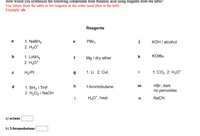
Chemistry
10th Edition
ISBN: 9781305957404
Author: Steven S. Zumdahl, Susan A. Zumdahl, Donald J. DeCoste
Publisher: Cengage Learning
expand_more
expand_more
format_list_bulleted
Question

Transcribed Image Text:How would you synthesize the following compounds from butanoic acid using reagents from the table?
Use letters from the table to list reagents in the order used (first at the left).
Example: ab
Reagents
1. NaBH4
PB13
KOH / alcohol
a
e
2. H30*
b
k
KOŁBU
1. LIAIH4
2. H30*
f
Mg / dry ether
H2/Pt
g
1. Li 2. Cul
1. СО2 2. НзО*
HBr, dark
no peroxides
d
h
1-bromobutane
m
1. BH3 / THF
2. H2O2 / NaOH
i
H3O*, heat
n
NaCN
a) octane
b) 2-bromobutane
Expert Solution
This question has been solved!
Explore an expertly crafted, step-by-step solution for a thorough understanding of key concepts.
Step by stepSolved in 2 steps with 2 images

Knowledge Booster
Learn more about
Need a deep-dive on the concept behind this application? Look no further. Learn more about this topic, chemistry and related others by exploring similar questions and additional content below.Similar questions
- 27 A chemist prepares a solution of sodium chloride (NaCl) by measuring out 0.50 g of NaCl into a 250. mL volumetric flask and filling to the mark with distilled water. Calculate the molarity of Cl anions in the chemist's solution. do Be sure your answer is rounded to 2 significant digits. 18 Ar mol x10 L Submit Assignment Continue 2022 McGraw Hill LLC. AIl Rights Reserved. Terms of Use Privacy Center Accessibility Show All IMG-6095.jpg IMG-6096.jpg IMG-6097.jpg IMG-6098.jpg IMG-6099.jpg MacBook Air DD DII F12 F11 F10 F9 80 F7 F8 F6 F5 F4 esc F2 F3 F1 & % @ # 7 8 3 4 5 6 1 2 { P E R Y Q W %24arrow_forwardheat (3 pts car of .COOH Na tBuOH/NH3arrow_forwardsee imagearrow_forward
- 11. Radon gas produces radioactive particles and in high concentrations can result in lung cancer in humans. The radon gas level inside a basement is measured at 4.5 × 10ª Curies/cm³. How many picoCuries of radon are present in the room if the room's dimensions are 7.2 m × 8.5 m × 4.0 m?arrow_forward) Ph CO0OH 2) EALI, H30* 3)PCCarrow_forwardAqueous hydrobromic acid HBr will react with solid sodium hydroxide NaOH to produce aqueous sodium bromide NaBr and liquid water H2O. Suppose 79.3 g of hydrobromic acid is mixed with 24. g of sodium hydroxide. Calculate the minimum mass of hydrobromic acid that could be left over by the chemical reaction. Be sure your answer has the correct number of significant digits.arrow_forward
arrow_back_ios
arrow_forward_ios
Recommended textbooks for you
 ChemistryChemistryISBN:9781305957404Author:Steven S. Zumdahl, Susan A. Zumdahl, Donald J. DeCostePublisher:Cengage Learning
ChemistryChemistryISBN:9781305957404Author:Steven S. Zumdahl, Susan A. Zumdahl, Donald J. DeCostePublisher:Cengage Learning ChemistryChemistryISBN:9781259911156Author:Raymond Chang Dr., Jason Overby ProfessorPublisher:McGraw-Hill Education
ChemistryChemistryISBN:9781259911156Author:Raymond Chang Dr., Jason Overby ProfessorPublisher:McGraw-Hill Education Principles of Instrumental AnalysisChemistryISBN:9781305577213Author:Douglas A. Skoog, F. James Holler, Stanley R. CrouchPublisher:Cengage Learning
Principles of Instrumental AnalysisChemistryISBN:9781305577213Author:Douglas A. Skoog, F. James Holler, Stanley R. CrouchPublisher:Cengage Learning Organic ChemistryChemistryISBN:9780078021558Author:Janice Gorzynski Smith Dr.Publisher:McGraw-Hill Education
Organic ChemistryChemistryISBN:9780078021558Author:Janice Gorzynski Smith Dr.Publisher:McGraw-Hill Education Chemistry: Principles and ReactionsChemistryISBN:9781305079373Author:William L. Masterton, Cecile N. HurleyPublisher:Cengage Learning
Chemistry: Principles and ReactionsChemistryISBN:9781305079373Author:William L. Masterton, Cecile N. HurleyPublisher:Cengage Learning Elementary Principles of Chemical Processes, Bind...ChemistryISBN:9781118431221Author:Richard M. Felder, Ronald W. Rousseau, Lisa G. BullardPublisher:WILEY
Elementary Principles of Chemical Processes, Bind...ChemistryISBN:9781118431221Author:Richard M. Felder, Ronald W. Rousseau, Lisa G. BullardPublisher:WILEY

Chemistry
Chemistry
ISBN:9781305957404
Author:Steven S. Zumdahl, Susan A. Zumdahl, Donald J. DeCoste
Publisher:Cengage Learning

Chemistry
Chemistry
ISBN:9781259911156
Author:Raymond Chang Dr., Jason Overby Professor
Publisher:McGraw-Hill Education

Principles of Instrumental Analysis
Chemistry
ISBN:9781305577213
Author:Douglas A. Skoog, F. James Holler, Stanley R. Crouch
Publisher:Cengage Learning

Organic Chemistry
Chemistry
ISBN:9780078021558
Author:Janice Gorzynski Smith Dr.
Publisher:McGraw-Hill Education

Chemistry: Principles and Reactions
Chemistry
ISBN:9781305079373
Author:William L. Masterton, Cecile N. Hurley
Publisher:Cengage Learning

Elementary Principles of Chemical Processes, Bind...
Chemistry
ISBN:9781118431221
Author:Richard M. Felder, Ronald W. Rousseau, Lisa G. Bullard
Publisher:WILEY